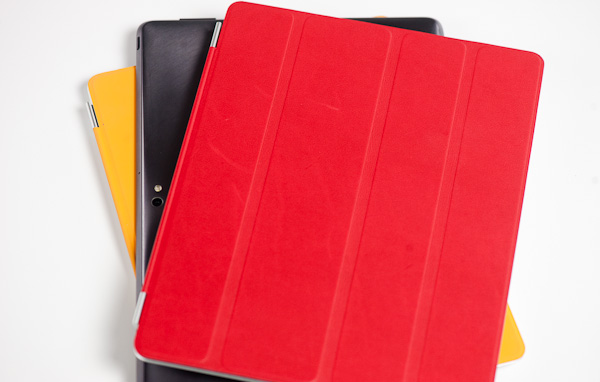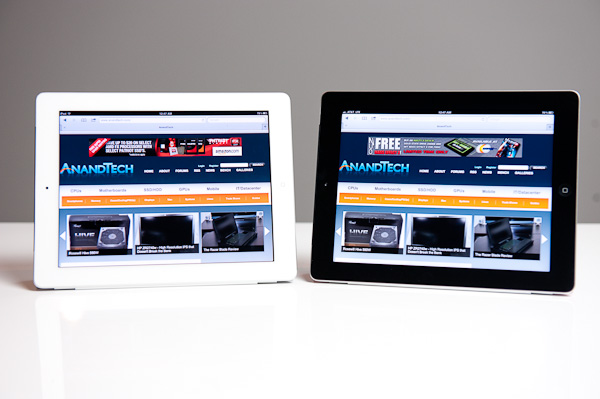The Apple iPad Review (2012)
by Vivek Gowri & Anand Lal Shimpi on March 28, 2012 3:14 PM ESTSince Apple launched the first iPad two years ago, the tablet market has evolved rapidly. While slate tablets were nothing new, the original iPad was the first serious tablet to be built around smartphone components and a user interface designed specifically for touchscreen input. The hardware was enough to run the OS smoothly while maintaining good battery life, the thin and light form factor lent itself to easy portability, and the touch-based user experience was miles better than earlier devices based on desktop operating systems.
We take it for granted now, but this was all news back in 2010, and the iPad was practically in a category of its own, with no real competitors to speak of. After Apple started shipping the iPad, the segment basically exploded—we had Google jump in with Honeycomb, HP got into it (and then out of it) with webOS, RIM had a go with the PlayBook, Amazon pushed the Kindle line into the tablet space, and Microsoft created its next release of Windows with tablets in mind. Along the way, Apple updated the iPad, both on the software side with multitasking, a new notifications system, and a myriad of UI updates, as well as launching second generation iPad hardware. The iPad 2 was a comprehensive update, bringing a dual core processor, unrivaled graphics performance, cameras fore and aft, and a ground up redesign that brought a thinner and lighter form factor.
The iPad 2 was a significant improvement over the original—faster, more portable, and generally a far more polished device. Not that it was perfect: iOS 4 still had issues with smooth multitasking and an archaic notifications system, the cameras were mediocre, and the XGA display, while a great quality panel, didn’t have the kind of pixel density expected of a premium mobile device. The iPad 2 hit market around the same time as Honeycomb (in Motorola’s Xoom) early last year, and at first Apple still held a major edge in terms of hardware. As more impressive Honeycomb devices like Samsung’s Galaxy Tab 10.1 and the ASUS Transformer Prime were launched, along with Ice Cream Sandwich looming on the horizon, Android became a much more viable tablet alternative to iOS. And with Microsoft planning for a major push later this year for ARM-based Windows 8 tablets centered around the Metro UI, Apple has never faced such stiff competition in the tablet space. Which brings us to the third generation of iPad hardware.
It has a display resolution that dwarfs most high-end desktop displays. The panel also puts a real emphasis on quality, not just resolution. For a computing device targeted squarely at the consumer market, both of these things are rarities.
Its SoC is the absolute largest ever squeezed into an ARM based tablet. The chip itself is even bigger than what you find in most mainstream notebooks. It’s expensive, it puts out a ton of heat and it offers a tremendous GPU performance advantage over anything else in its class.
And it has a battery that’s larger than what ships in the current crop of similarly sized ultraportables and Ultrabooks.
The new iPad doesn’t significantly change the tablet usage paradigm, but it does put all previous attempts at building hardware in this space to shame. It’s the sort of no holds barred, performance at any expense design that we’re used to seeing from enthusiast PC component vendors—but in a tablet...from Apple.
Welcome to the new iPad.












234 Comments
View All Comments
Riseofthefootclan - Thursday, March 29, 2012 - link
I entered the tablet market this year in hopes of enhancing my school experience. I was looking for a device that would do the following: reading textbooks, slides, notes, watching video etc.I too looked at the kindle, but I will tell you now that for what you want I'd avoid it.
I first purchased a Samsung galaxy tab 10.1 LTE. I wanted Internet every where I went, but soon became frustrated with the android operating system (inconsistently chunky etc).
After playing with an iPad 2 in the store, I realized it was a much better experience. Fluid and problem free.
A month later the iPad 3 (new iPad) is released. After playing with it I realized how much better the screen was, and how much that impacted the experience (especially for someone who primarily uses the device for text consumption).
So now, here I sit, with a 32b LTE iPad 3. I don't regret the purchase one bit. Armed with the Bluetooth keyboard, or just the on screen variant, I can also take notes quite competently (wrote this entire thing out with the on screen keyboard).
Best educational tool I have ever purchased. In my hands I can carry my one stop shop for web browsing, email, textbooks, fictional books, course materials, lectures and even games.
Coming from an iPad 2, I'd go so far as to say it was well worth the upgrade.
I highly recommend picking one of these up, as I believe it will fit your bill of requirements to a tee.
adityarjun - Thursday, March 29, 2012 - link
Thanks dude! And all others who replied. I guess I will be picking up a 32gb LTE version of the ipad.Do you guys know whether the ipad has international warranty? If I were to buy it from the US and import it here, would I have warranty?
And how many years of warranty does it have? Is it a replacement warranty, i.e. , if anything is broken they give a new ipad or a normal warranty?
This is another aspect the review didnt cover. A para detailing the warranty and tech support should have been there imo.
adityarjun - Thursday, March 29, 2012 - link
Oops forgot to add this in the comment above-- which keyboard are you using.. I think I will pick the Logitech one.And any good stylus?
Also, for protection I guess I will go with a Zagg shield and the smart cover. Will that be enough?
OCedHrt - Thursday, March 29, 2012 - link
How come the review starts with the 10.1-inch 1920 x 1200 Super IPS+ tablet but all the comparisons are with the 1280 x 800 tablet?adityarjun - Thursday, March 29, 2012 - link
I am not sure but I dont think that those tablets are in the market yet. That was just a comparison of specs. Later on we had a comparison with other major tablets available in the market currently.i.e ipad 2 and the transformer prime.OCedHrt - Thursday, March 29, 2012 - link
Says 40 nm on page 2 and 45 nm on page 6.g1011999 - Thursday, March 29, 2012 - link
At Page (The A5X SoC) / Table (ARM Cortex A9 Based SoC Comparison)The cell for "A5X" and "Memory Interface to the CPU" shall be "Quad channel(128bit)"
Ryan Smith - Thursday, March 29, 2012 - link
Actually that's correct as it stands. The memory interface to the CPU is 64bit on the A5X. The other two memory channels go to the GPU, rather than the CPU.g1011999 - Thursday, March 29, 2012 - link
No, Those memory controllers are multi-port AXI controller which are connected to L2 cache controller, system fabrics, GPU.L2 cache controller is connected to all those 128bit dram controller, either through direct connection (memory adapter like omap 4470) or through system AXI bus, so the cpu can access all the memory.
The A5X is a SoC coupled with 128bit quad channel DRAM regardless whether the bandwidth from CPU(L2 cache) to memory is sufficient or not.
The IPs ( CPU, video codec, display controller, GPU, CAM-IF ...) on SoC can take advantage from the 128bit memory interface with less chance of congestion.
PeteH - Friday, March 30, 2012 - link
And how do you know the internal system bus is AXI?